What is Feijoa?
Feijoa, also known as pineapple guava or guavasteen, is a unique and nutritious fruit native to the highlands of southern Brazil, parts of Colombia, Uruguay, Paraguay, and northern Argentina. With its sweet, aromatic flavor, feijoa is not only a delightful addition to various dishes but also a powerhouse of health benefits. This article delves into the numerous health advantages and uses of feijoa, highlighting its potential as a superfood.
Nutritional Profile of Feijoa
Feijoa is rich in essential nutrients, making it a valuable addition to a balanced diet. A typical serving of feijoa (100 grams) provides:
- Calories: 55
- Carbohydrates: 13 grams
- Dietary Fiber: 6 grams
- Vitamin C: 32.9 mg (55% of the Daily Value)
- Vitamin B6: 0.1 mg (5% of the Daily Value)
- Potassium: 172 mg (5% of the Daily Value)
In addition to these, feijoa contains smaller amounts of vitamins A, E, and K, as well as folate, magnesium, and manganese.
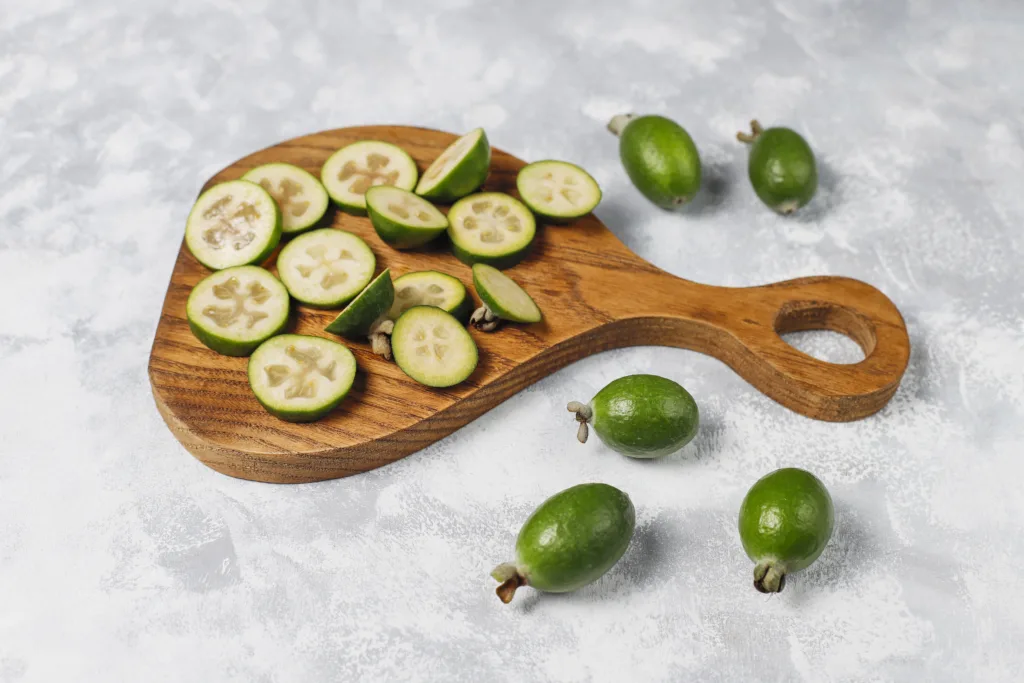
Health Benefits of Feijoa
1. Boosts Immune System
Feijoa is an excellent source of vitamin C, a powerful antioxidant that plays a crucial role in strengthening the immune system. Regular consumption of feijoa can help ward off infections and keep common illnesses like colds and flu at bay.
2. Improves Digestive Health
With its high fiber content, feijoa aids in maintaining a healthy digestive system. Dietary fiber promotes regular bowel movements, prevents constipation, and supports overall gut health. The natural enzymes in feijoa also facilitate better digestion and nutrient absorption.
3. Supports Heart Health
Feijoa is a heart-friendly fruit, thanks to its potassium content, which helps regulate blood pressure. Potassium balances sodium levels in the body, reducing the risk of hypertension and cardiovascular diseases. Additionally, the fiber in feijoa helps lower cholesterol levels, further benefiting heart health.
4. Enhances Skin Health
The antioxidants in feijoa, particularly vitamin C, play a significant role in maintaining healthy skin. Vitamin C promotes collagen production, which is essential for skin elasticity and wound healing. Antioxidants also protect the skin from damage caused by free radicals, reducing signs of aging.
5. Aids in Weight Management
Feijoa is a low-calorie fruit that is rich in dietary fiber, making it an ideal choice for those looking to manage their weight. The fiber content helps keep you feeling full for longer, reducing overall calorie intake and aiding in weight loss efforts.
6. Regulates Blood Sugar Levels
Feijoa has a low glycemic index, which means it does not cause a rapid spike in blood sugar levels. This makes it a suitable fruit for people with diabetes or those at risk of developing the condition. The fiber in feijoa also helps in stabilizing blood sugar levels.
7. Supports Eye Health
Feijoa contains a good amount of vitamin A and other antioxidants that are beneficial for eye health. Vitamin A is essential for maintaining good vision and preventing eye disorders such as macular degeneration and cataracts. The antioxidants in feijoa help protect the eyes from damage caused by free radicals, ensuring better eye health.
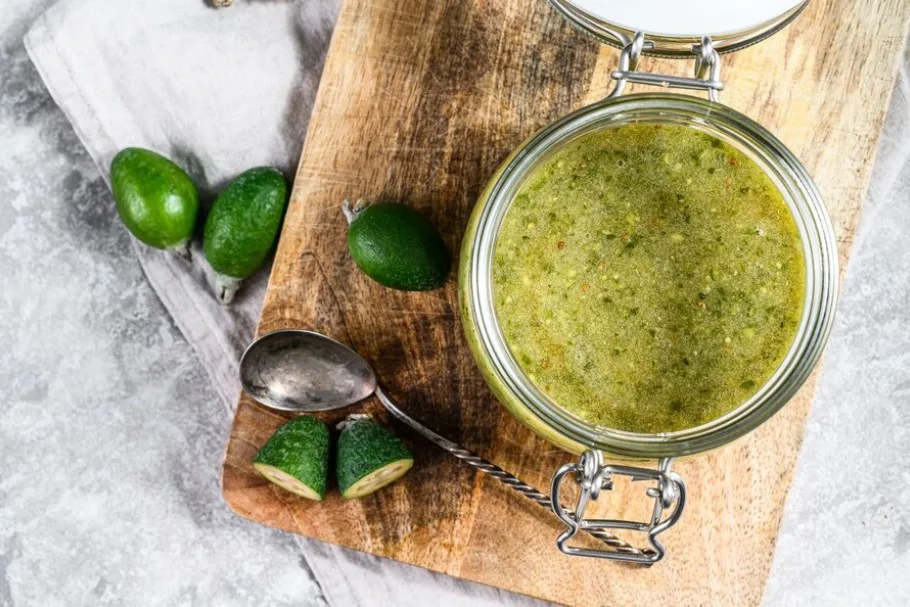
Uses of Feijoa in Culinary Delights
1. Fresh Consumption
One of the simplest ways to enjoy feijoa is by eating it fresh. The fruit can be sliced in half and scooped out with a spoon. Its unique flavor, a blend of pineapple, guava, and mint, makes it a refreshing snack.
2. Smoothies and Juices
Feijoa can be a fantastic addition to smoothies and juices. Blend feijoa with other fruits like banana, apple, or berries to create a nutritious and delicious drink. Adding feijoa to your morning smoothie is an excellent way to start the day with a burst of vitamins and minerals.
3. Desserts and Baked Goods
Feijoa’s sweet and tangy flavor pairs well with various desserts and baked goods. It can be used in pies, tarts, cakes, and muffins. Feijoa jam, made by cooking the fruit with sugar and lemon juice, is another delightful way to enjoy its flavor.
4. Salads
Add a tropical twist to your salads by incorporating fresh feijoa slices. It pairs well with greens, nuts, and cheese, adding a burst of flavor and nutrients to your dish. Feijoa can also be used in fruit salads for a refreshing and healthy dessert.
5. Sauces and Chutneys
Feijoa can be used to make flavorful sauces and chutneys that complement a variety of dishes. A feijoa chutney made with spices, vinegar, and sugar can be a delicious accompaniment to meats and cheeses.

Growing Feijoa at Home
1. Climate and Soil Requirements
Feijoa plants thrive in subtropical and temperate climates. They prefer well-drained soil with a slightly acidic to neutral pH. Feijoa trees are fairly hardy and can withstand light frosts, making them suitable for growing in a variety of regions.
2. Planting and Care
Feijoa can be grown from seeds or cuttings. When planting, choose a sunny spot with well-drained soil. Regular watering is essential, especially during the fruiting season, but avoid waterlogging. Pruning helps maintain the plant’s shape and encourages better fruit production.
3. Harvesting
Feijoa fruits are usually ready for harvest in late autumn. The fruit is ripe when it falls to the ground, but you can also pick it when it is slightly soft to the touch. Store harvested feijoas in a cool, dry place to extend their shelf life.
Conclusion
Feijoa is a versatile and nutritious fruit that offers numerous health benefits. Its rich vitamin and mineral content, along with its delightful flavor, make it a valuable addition to any diet. Whether consumed fresh, added to smoothies, or used in various culinary creations, feijoa can enhance your overall health and well-being. Moreover, growing feijoa at home can be a rewarding experience, providing you with a steady supply of this superfruit. Incorporate feijoa into your daily routine and reap the myriad health benefits it has to offer.
Topics covered
- What is Feijoa?
- What are key nutrients in Feijoa?
- What are health benefits of Feijoa?
- How is Feijoa good for health?
- What are uses of Feijoa?
- How to use Feijoa?
- Recipes of Feijoa.
- How to grow Feijoa?

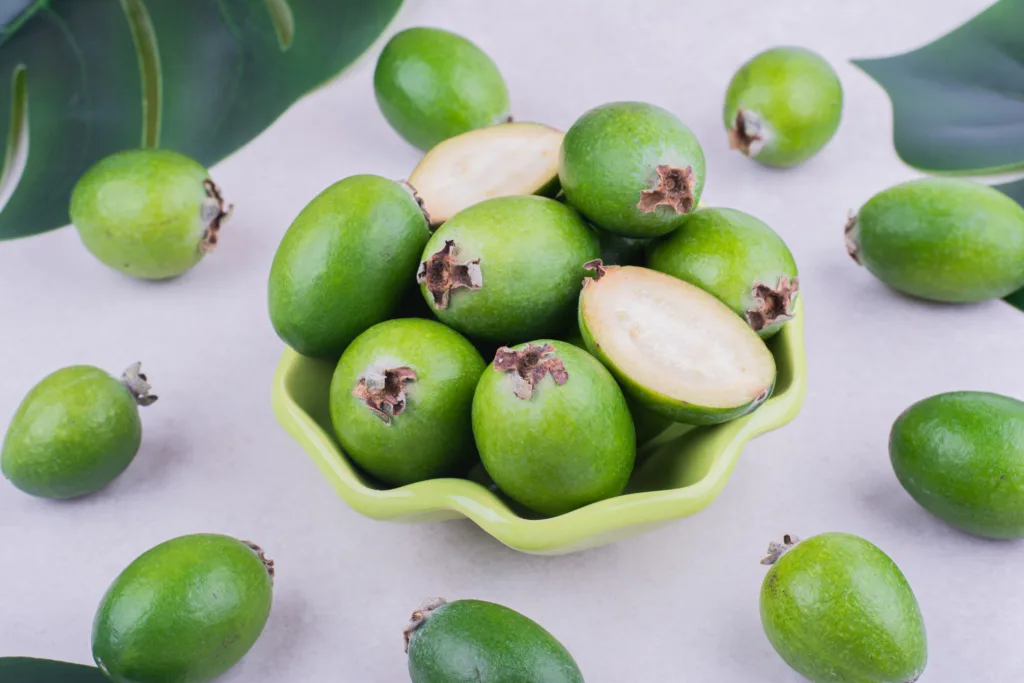
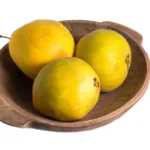
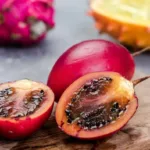
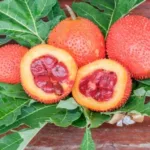
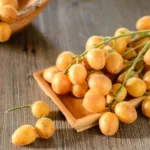
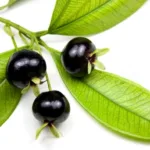

Superb and well-thought-out content! If you need some information about Cosmetics, then have a look at FQ5